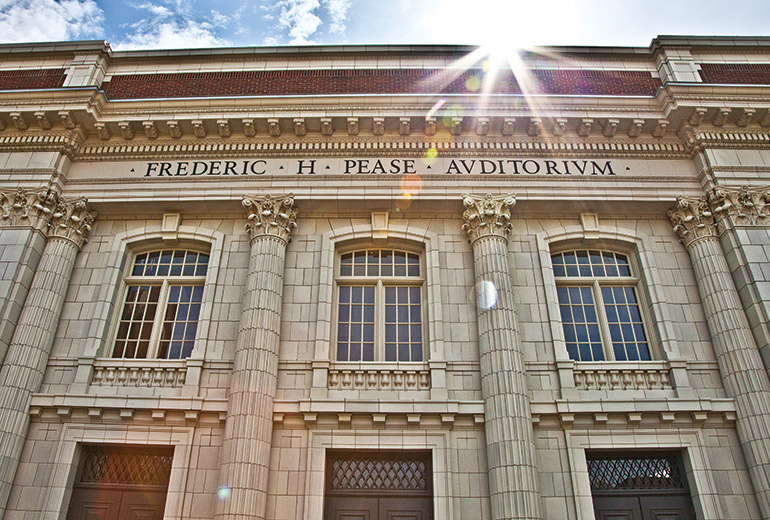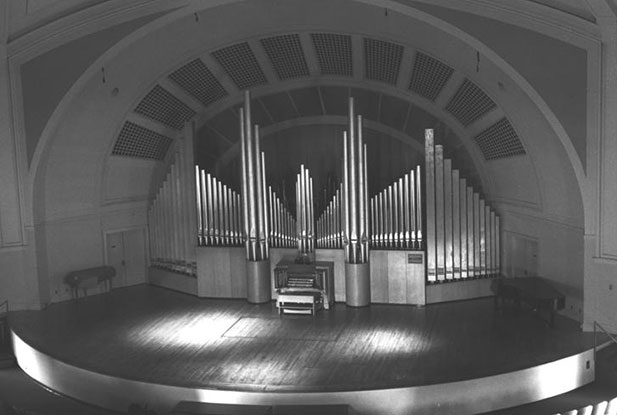
As it enters its second century, Pease Auditorium still embodies the elegance of its era. From its Romanesque exterior, trimmed in carved marble, to the delicate arches, domed ceiling, and 4,397-pipe organ inside, the building is a testament to early 20th-century opulence.
But to Eastern Michigan and the surrounding community, Pease is much more than a pretty face. Built in 1914 at the southern edge of campus, the auditorium was the largest performance venue in the city of Ypsilanti until the EMU Convocation Center opened in 1997.
“Through it, we can really access a hundred years of history,” says Diane Winder, head of the Department of Music and Dance. “If you could shake its walls, the greatest music and the greatest speakers of the century would fall out.”

In 1960, the organ is installed, made possible by a donation from emeritus faculty member Frederick Alexander
Eleanor Roosevelt spoke to a packed auditorium about the struggle between democracy and the rising power of the Soviet Union on a November evening in 1957. “The American people face a great challenge today,” she said. “We must prove that, with freedom, we can accomplish the same as the Soviet Union without freedom.”
Bobby Kennedy addressed an enthusiastic crowd from the steps of Pease one chilly October morning in 1966. “How many favor pulling out of Vietnam?” Kennedy asked. “Who's against escalation?” Almost every hand in the audience flew up in agreement.
Legendary poet Maya Angelou spent an evening there in 1996 encouraging listeners to immerse themselves in poetry, to study the “rich and real” works of 19th and 20th-century African-American poets, classics like Shakespeare and Poe, and writers of every demographic and background. The words, she said, are spendable currency.
"If you could shake its walls, the greatest music and the greatest speakers of the century would fall out."
In 1923, John Philip Sousa led his band through Depot Town and Ypsilanti to perform at Pease, which overflowed with community members excited to see the March King in person in their hometown.
Musicians from the Temptations to the Ben Folds Five to the Roots and the Drifters and Alison Krauss and Union Station have all appeared there, and so did renowned cult film director John Waters.
“It became a window to the world for the city of Ypsilanti and the campus,” says Kristy Meretta, an emeritus professor who taught oboe for 31 years.
When Pease opened, Ypsilanti was still a rural, dirt-road town, and Eastern, then called Michigan State Normal College, had only a handful of buildings. It was a thriving social center for both the city and campus from day one and classes would often be canceled when headlining acts arrived.
But Pease has been much more than a performance venue. The Department of Music and Dance's offices were located on the second floor for many years, just above the main entrance, and professors gave lessons in the teaching studios scattered throughout the building.
It's no surprise that a building as old and storied as Pease has spawned its share of urban legends. One involves a pair of music majors whose romantic relationship ended in a jealousy-driven murder. Another claims that the spirit of Frederic H. Pease himself, the building's namesake, lurks in the building.
A student named Timothy Harrower wrote a spellbinding account called "The Ghost of Pease Auditorium" for the April 1980 edition of the former EMU magazine Spectrum. Despite being clearly labeled as historical fiction, its popularity helped establish the spooky tale in campus folklore.
“A lot of people I don't even know kept coming up to me in the halls, asking me if it's real and if I've seen the ghost,” Harrower told the Eastern Echo. “I've gotten a lot of reaction from it.” Barbara Weiss, concertmistress of the college orchestra in the late 1930s, believed Pease had an unearthly resident.
“There is a ghost in there,” Weiss insisted in a 1995 interview with the University. “I have definitely felt another presence on the stage. It's like the Phantom of the Opera, but this is a nice ghost.”
Its supernatural dimension may be iffy, but there's no question that Pease has molded unforgettable memories for its patrons.
“My eyes still fill with tears as I remember my first experience at Pease Auditorium,” wrote Christine Rowley, sharing her 50-year-old memories in a letter to the Friends of Pease in the 1990s. Rowley, who attended EMU from 1937 to 1941, made her way to Pease through a blizzard to hear a symphony orchestra for the first time. Because of the storm and a power outage, the entire performance was candlelit and the audience was small.
Nonetheless, wrote Rowley, “When the first notes of music filled the auditorium, the tears streamed down my face at its beauty.”
“Past, present, and future are really important to an institution,” says Elizabeth King, former Dean of Health and Human Services, who was a key player in the drive to renovate Pease in the early 1990s. “Our past is a foundation for our future.”
“Pease Auditorium is made up of more than brick and mortar,” says emeritus professor Meretta. “Pease Auditorium is made up of experiences that came before and come with us and will come after us.”
